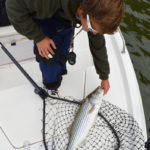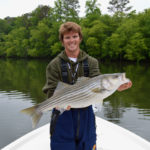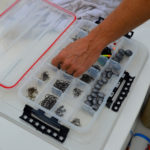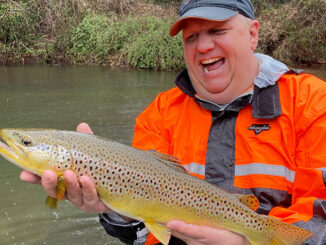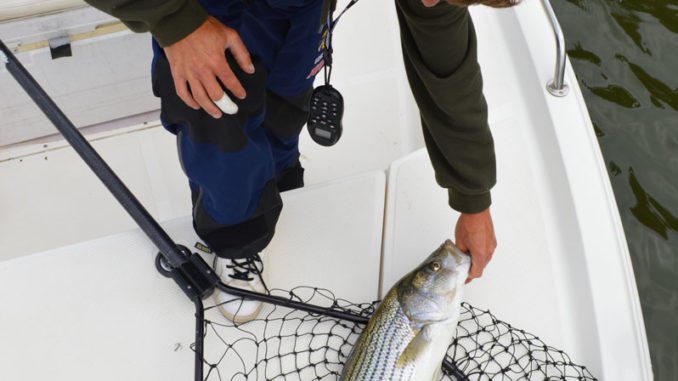
Live bait is hard to beat when stripers have finished their spring run upstream on Lake Hickory.
Being 100 miles inland at the foot of the Appalachian mountains, mere yards from the Hickory Regional Airport, Lake Hickory might seem is an unlikely spot for trophy striped bass, but many anglers are finding this sliver of a lake to be a good bet for landing quality fish.
Created in 1927 when Oxford Dam was built on the Catawba River just upstream from the NC 16 bridge, Lake Hickory covers 4,223 acres between Oxford Dam and Rhodhiss Dam upstream. The lake is still riverine, winding along the riverbed and remaining comparatively narrow. Anglers can find fish year-round here if they are willing to find the sweet spot between the concrete walls.
Finding stripers is a necessity for guide Colt Bass — yes, his last name really is Bass — who spends at least three days a week on Lake Hickory, with our within clients. He focuses on trolling to hook up on stripers, because keeping multiple baits in the water and covering lots of territory gives the best chance for finding fish.
Bass trolls six baits at a time. Two rods rest in rod holders on the gunwales on either side of the boat, using planer boards to pull the baits away from the boat. Two more rods run at angles out from the corners of the transom, at’s stern, and two drop straight down behind the boat with bait down on downriggers. Between them, they cover the widest range of water possible.
The action can turn on in a second. A strike may come on the rod on the right side of the boat, then one of the downrigger baits is struck from deep below the water line. Soon, multiple fish are hooked and waiting to be reeled in. Sometimes Bass has to grab a rod and start reeling because the clients are busy with fish of their own.
Bass finds most of his spring fish on the upper end of the lake; in the summer, the action moves down to the lower end. Whether these migrations are holdovers from spawning instinct is anyone’s guess, but the changes are fairly predictable. On the lower end, he’ll use an umbrella rig, trolling at 2 mph. When he’s on the upper end, he’ll troll around 1 mph with single baits on each rod.
Part of the success Bass enjoys comes from his use of live bait. He’s not above using a lure, but he makes it a priority to get fresh bait so clients have the best chance at landing a whopper.
“They say it’s lazy-man’s fishing, but if a man uses a cast net, catches bait, runs five or six lines — it ain’t lazy man’s fishing for me,” Bass said.
Three species of baitfish make up his Lake Hickory arsenal: gizzard shad, threadfin shad and blueback herring. All three are found in the lake and play on a striper’s natural feeding pattern.
When he first started guiding, catching bait meant getting out on the water in the predawn darkness to catch shiners before a client showed up. Nowadays, he uses a 150-gallon aerated tank at his home to house baitfish for several days — even weeks. He has an old well on his property that helps keep the bait in healthy condition before they meet up with hooks, line and sinkers.
Bass said baitfish are an inexpensive and renewable way to land striped bass. A fisherman can buy a cast net and catch shad over and over for the same price as a few artificial lures.
“You could buy seven or eight crankbaits or use the same money to buy a cast net,” said Bass, who doesn’t think stripers are skittish around live bait they way they often are around artificial lures.
“The great thing about live bait is I can come back up here, and that striper will eat bait again tomorrow. He won’t get fooled and try for a spinnerbait two days in a row,” Bass said.
The best results come from using smaller treble hooks — incredibly small considering the big fish you’re liable to reel in at Hickory. The average crankbait comes with a No. 6 treble hook, and Bass said that’s the size you need.
“The first time I saw it, I didn’t believe that they could catch a big 10-, 15- or 18-pound striper,” Bass said. “But the important thing is to use the smallest hook that will do the job. That way, the bait will swim naturally under the water.”
He also uses circle hooks to safely release fish.
Lake Hickory is seeing a resurgence after a rough 2013 season. Heavy rains that year led many fishermen to believe that high waters had washed the larger fish over the Oxford Dam’s spillway. Fishing got so bad that anglers requested that the N.C. Wildlife Resources Commission assess the striper population. Surveys were done, and they determined that there were plenty of stripers in Lake Hickory, but the majority were 2 1/2-year-olds.
Last year, the Commission instituted a 20-inch minimum on striped bass at Lake Hickory, which allows fish to grow for a few years before they can be taken. That suits Bass just fine, because he has a catch-and-release policy, even for trophy fish. He recommends a taxidermist to his clients and takes multiple pictures and measurements for a realistic replica to be made — then returns the fish to the lake.
Hickory’s relative anonymity means that many anglers don’t even think of dropping a line here to begin with.
“Not many people know about Lake Hickory. It’s not a lake you hear about three states away, but that’s what makes it so great,” Bass said. “It’s not the best I’ve ever seen, but it’s a lot better than last year.”

